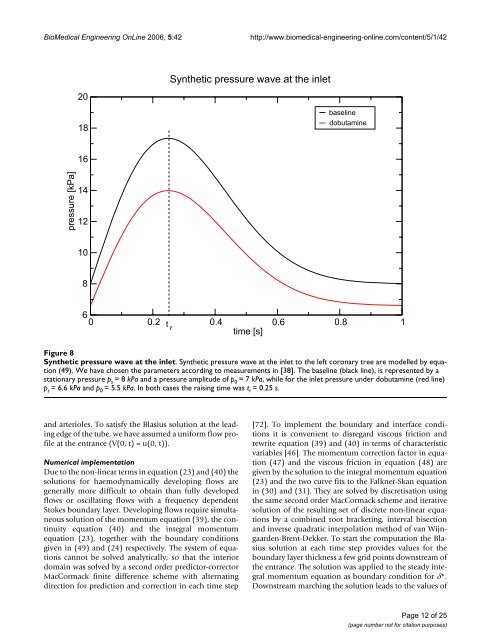Transient integral boundary layer method to calculate the ...
Transient integral boundary layer method to calculate the ...
Transient integral boundary layer method to calculate the ...
Create successful ePaper yourself
Turn your PDF publications into a flip-book with our unique Google optimized e-Paper software.
BioMedical Engineering OnLine 2006, 5:42http://www.biomedical-engineering-online.com/content/5/1/42 Syn<strong>the</strong>tic Figure 8 pressure wave at <strong>the</strong> inletSyn<strong>the</strong>tic pressure wave at <strong>the</strong> inlet. Syn<strong>the</strong>tic pressure wave at <strong>the</strong> inlet <strong>to</strong> <strong>the</strong> left coronary tree are modelled by equation(49). We have chosen <strong>the</strong> parameters according <strong>to</strong> measurements in [38]. The baseline (black line), is represented by astationary pressure p s = 8 kPa and a pressure amplitude of p 0 = 7 kPa, while for <strong>the</strong> inlet pressure under dobutamine (red line)p s = 6.6 kPa and p 0 = 5.5 kPa. In both cases <strong>the</strong> raising time was t r = 0.25 s.and arterioles. To satisfy <strong>the</strong> Blasius solution at <strong>the</strong> leadingedge of <strong>the</strong> tube, we have assumed a uniform flow profileat <strong>the</strong> entrance (V(0, t) = u(0, t)).Numerical implementationDue <strong>to</strong> <strong>the</strong> non-linear terms in equation (23) and (40) <strong>the</strong>solutions for haemodynamically developing flows aregenerally more difficult <strong>to</strong> obtain than fully developedflows or oscillating flows with a frequency dependentS<strong>to</strong>kes <strong>boundary</strong> <strong>layer</strong>. Developing flows require simultaneoussolution of <strong>the</strong> momentum equation (39), <strong>the</strong> continuityequation (40) and <strong>the</strong> <strong>integral</strong> momentumequation (23), <strong>to</strong>ge<strong>the</strong>r with <strong>the</strong> <strong>boundary</strong> conditionsgiven in (49) and (24) respectively. The system of equationscannot be solved analytically, so that <strong>the</strong> interiordomain was solved by a second order predic<strong>to</strong>r-correc<strong>to</strong>rMacCormack finite difference scheme with alternatingdirection for prediction and correction in each time step[72]. To implement <strong>the</strong> <strong>boundary</strong> and interface conditionsit is convenient <strong>to</strong> disregard viscous friction andrewrite equation (39) and (40) in terms of characteristicvariables [46]. The momentum correction fac<strong>to</strong>r in equation(47) and <strong>the</strong> viscous friction in equation (48) aregiven by <strong>the</strong> solution <strong>to</strong> <strong>the</strong> <strong>integral</strong> momentum equation(23) and <strong>the</strong> two curve fits <strong>to</strong> <strong>the</strong> Falkner-Skan equationin (30) and (31). They are solved by discretisation using<strong>the</strong> same second order MacCormack scheme and iterativesolution of <strong>the</strong> resulting set of discrete non-linear equationsby a combined root bracketing, interval bisectionand inverse quadratic interpolation <strong>method</strong> of van Wijngaarden-Brent-Dekker.To start <strong>the</strong> computation <strong>the</strong> Blasiussolution at each time step provides values for <strong>the</strong><strong>boundary</strong> <strong>layer</strong> thickness a few grid points downstream of<strong>the</strong> entrance. The solution was applied <strong>to</strong> <strong>the</strong> steady <strong>integral</strong>momentum equation as <strong>boundary</strong> condition for δ*.Downstream marching <strong>the</strong> solution leads <strong>to</strong> <strong>the</strong> values ofPage 12 of 25(page number not for citation purposes)









